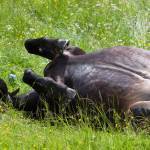Hindgut Bacteria Play Role in Laminitis, Colic in Horses

Colic and laminitis, two of the most common equine ailments, can both result from overconsumption of high-carbohydrate concentrates or lush grass. Research has supported this cause-and-effect relationship, but the full story is more complicated. Some horses develop laminitis for reasons unrelated to diet, and colic can occur in horses with even the most carefully managed feed programs.
Scientists at the University of Massachusetts have carried out research* to determine how the hindgut microbial makeup is related to colic and laminitis. Three healthy mature Morgan geldings were used in the study. The horses were first turned out to graze, and were later given diets enriched with starch, lactate, or starch and lactate. Feces were collected from the horses during each treatment, and changes were monitored in bacterial numbers, types, and metabolites for each horse as the diets were changed.
Horses get nutrients and energy from the fermentation of forage materials in the hindgut. Up to 70% of the horse’s energy is derived from short chain fatty acids produced by fermentation. When large carbohydrate-rich meals are eaten, some of the carbohydrate escapes digestion in the small intestine, spilling over into the hindgut where it disrupts the balance of microbes. The chemical changes that result from this imbalance lead to rising lactic acid levels and an increase in toxins caused by the death of some hindgut microorganisms. These conditions put affected horses at a higher than normal risk for colic and laminitis.
In the study, researchers identified bacteria that raise lactate levels and others that use lactate. A low level of lactate is always present in the hindgut, but there are variations in hindgut pH as bacterial populations increase and decrease in response to dietary modifications. These changes and their causes are not well understood as they relate to the course of an event like laminitis. An acidic shift favors the growth of acid-loving bacteria, while other microbes die in the same conditions. All types of acid-loving bacteria may not respond in exactly the same way, and different kinds of microbes that survive the hostile environment may play various roles in the return to normal hindgut conditions.
The horses in the study showed significant differences in their response to dietary changes and their ability to reduce accumulated hindgut lactate. This was related at least partly to the fact that microbial cultures varied, with different horses having more or fewer bacteria with the ability to reduce acidosis. For instance, one particular family of lactate-using microbes increased in all horses, but by 48 hours after the starch and starch/lactate enrichments, there were large differences between the cultures from horse 3, where these microbes dropped to 5%, and those from horses 1 and 2 where the same microbes accounted for 70% of the total. When the researchers measured other microbial populations, one type increased while another decreased in two of the horses. In the third horse, both populations decreased at the same time. These differences in horses that were similar in age, breed, gender, and diet could help to explain why some horses are more susceptible to colic and laminitis, while others stay healthy after undergoing similar challenges.
Differences between horses tend to rule out a “one explanation fits all” scenario, and these variations also mean that preventing colic and laminitis is not easy. In the future, more study of lactate-producing and lactate-using bacteria might lead to the development of probiotics that could guard horses against diet-induced upsets like colic and laminitis. Until that time, owners can minimize the risk by keeping grain meals small, making feed changes gradually, and limiting or eliminating grazing time for animals that are particularly sensitive to sugars contained in fresh grass.
The pH of the hindgut varies as bacterial populations increase and decrease in response to dietary modifications. EquiShure is a time-released buffer targeting the hindgut. EquiShure helps moderate gut conditions by preventing the drastic drop in pH associated with high lactate production and supports lactic-acid-utilizing bacteria. Learn more.
Biddle AS, Black SJ, Blanchard JL (2013) An In Vitro Model of the Horse Gut Microbiome Enables Identification of Lactate-Utilizing Bacteria That Differentially Respond to Starch Induction. PLoS ONE 8(10): e77599.








